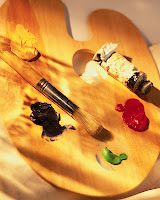We recently spent a month doing a lesson on Authors as Mentors. This is where we really delve into one author's work and read several of his/her books, analyze and discuss the writing and finally, try to model our own writing after our author mentor. We did this in our Reading Club and Writer's Workshop.
I did some research on what authors to include and I settled on Tomie DePaola and Patricia Polacco. My older daughter had done this same lesson when she was in school and she loved the Tomie DiPaola books and I still had them so it seemed natural to start this lesson with his work.
· We reviewed different writing techniques such as simile, alliteration, metaphor, hyperbole, and onomatopoeia.
· We practiced using those techniques.
· We talked about Tomie DePaola and we read a brief biography to understand how Tomie became an author and illustrator. We also learned how he comes up with ideas for his stories.
· I read aloud one of his books and we tried to find some of the writing techniques we had previously learned.
· In Writer's Workshop, we brainstormed ideas for our own story. We talked about things that were happening in Buttercup's life at the time (ice skating lessons, a visit to her cousins' house, getting our Christmas picture taken)
· I encouraged Buttercup to write down all of those ideas. For now, we would only pick one, but we agreed that it would be good to keep a list for future stories.
· She picked a topic and told the story on 5 fingers.
· Then, she wrote those 5 sentences down.
· We alternated days in Reading Club and Writer's Workshop; that means, we would read aloud on one day, and do some writing the next day.
· In Reading Club, we read other Tomie DePaola books and talked about writing techniques that he used in all of the books we read.
· Some of the things we noticed were:
o He names the setting within the first sentence.
o He uses words in Italian.
o He uses words in bold letters for emphasis.
o He uses what we call the list of 3 (naming 3 things within a sentence).
o His stories are about him or things he heard or experienced growing up.
· Since Buttercup had already written her story in 5 sentences, we went back to edit the story and try to include some of our mentor author's techniques.
· When Buttercup was happy with her story, we cut out strips of paper (5, one for each sentence of her story). She re wrote her sentences on each strip of paper.
· She then glued the sentences to the bottom of a bigger piece of construction paper.
· Next, Buttercup made a drawing to go along with each sentence of her story. As our mentor author is also an artist and illustrated his own books, we thought it would be perfect for Buttercup to illustrate her book too.
Buttercup is so proud of her book. She loves to go back and read it every once in a while. Writing was such a challenge for her because she thought it was boring and never had ideas. Giving her some structure, encouraging her to jot down moments she may want to remember later, and guiding her through the process has made the writing process much easier.
We followed the same process as we read through some of Patricia Polacco's books. And Buttercup wrote another book.
Success!!
















.JPG)
.JPG)
.JPG)
.JPG)








.JPG)








.JPG)
.JPG)
.JPG)










